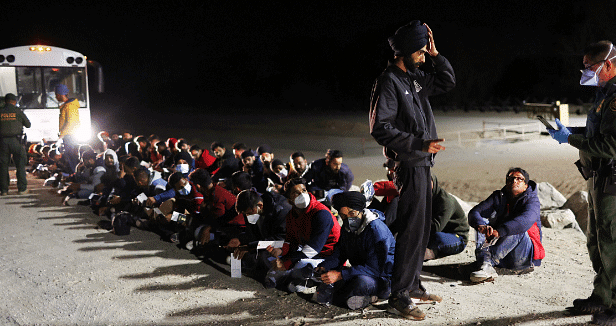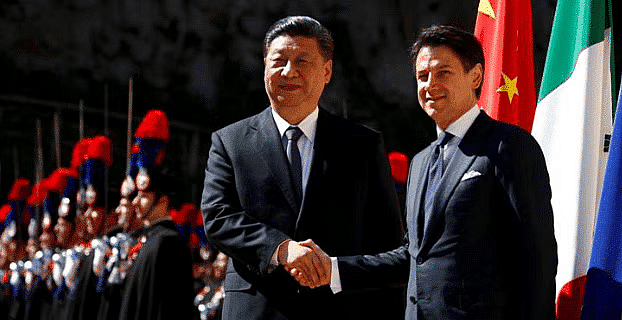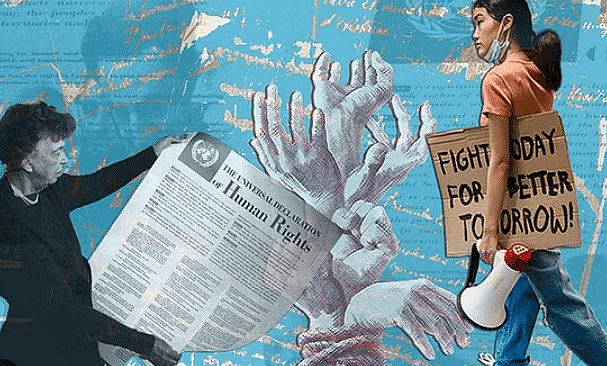International Relations: December 2023 UPSC Current Affairs | UPSC Mains: International Relations PDF Download
Illegal Indian Migration to the U.S.
Context: As per data from the U.S. Customs and Border Protection, there has been a notable increase in the quantity of unauthorized Indian migrants entering the USA.

What is Migration?
- Migration is the movement of people from one place to another, either permanently or temporarily.
- The International Organization for Migration defines a migrant as any person who is moving or has moved across an international border or within a state away from his/her habitual place of residence.
Reasons Behind the Surge in Unauthorized Migration:
Push Factors
- Limited job prospects and constrained economic opportunities in India impel individuals to seek better possibilities abroad.
- Some individuals are driven by social unrest or a lack of confidence in India's governance, prompting them to search for stability elsewhere.
Pull Factors
- The USA is renowned for offering improved job opportunities, higher wages, and prospects for career advancement.
- The country's prestigious academic institutions and quality education attract students.
- Desire for family reunification with relatives already residing in the USA is a motivating factor.
Global Migration Trends
- Following the COVID-19 pandemic, there has been a noticeable global increase in migration.
- Many individuals are seeking improved opportunities and enhanced security in different countries.
Visa Delays and Alternative Entry Routes
- Lengthy visa waiting periods lead individuals to contemplate illegal entry into the USA, as legal options are limited and time-consuming.
- Smugglers now provide sophisticated and sought-after assistance for unlawful entry into the country.
Misinformation
- False information disseminated on social media and deceitful practices by travel agencies misguide desperate migrants.
- Such misinformation compels individuals into perilous journeys facilitated by multiple agents across continents.
Implications for India:
- Bilateral Relations: This issue has the potential to affect the relationship between India and the USA, potentially influencing trade negotiations, security cooperation, and strategic partnership.
- Economic Factors: The potential outflow of skilled individuals seeking illegal entry could lead to a brain drain that might impact India's economy, especially in sectors where skilled labor is in high demand.
- Labor Market Challenges: The departure of skilled or semi-skilled workers could result in labor shortages in specific sectors, impacting India's workforce and economic output.
- Policy Repercussions: India might need to enforce stringent policies to address the factors driving illegal migration, potentially diverting resources and attention away from other developmental priorities.
Conclusion
India should aim to create more jobs, support its economy, and help people at home while engaging in diplomatic dialogues with other countries to solve migration issues and protect migrants' rights together.
Italy Withdraws from China’s BRI
Context: In recent developments, Italy has officially exited the China Belt and Road initiative (BRI). Despite being a member of both the European Union and NATO, Italy had joined the BRI in 2019 during the tenure of then Prime Minister Giuseppe Conte.
Why did Italy join the Belt and Road initiative?
- Italy signed it when the populist Five Star Movement party-led government promoted it as a way of increasing trade with China while getting investments in major infrastructure projects.
Why has Italy withdraws from China Belt and Road Initiative?
- Rising Trade Deficit & lack of Investment: In the intervening years, Italy’s trade deficit with China has ballooned from 20 billion euros to 48 billion euros ($21.5 billion to $51.8 billion.)
- Promised investments in Italian ports were never achieved.
About China Belt and Road initiative
Origin:
- In 2013, Chinese President Xi Jinping, during visits to Kazakhstan and Indonesia, outlined a vision to establish both a Silk Road Economic Belt (SERB) and a 21st Century Maritime Silk Road (MSR) to overcome the constraints in Asian connectivity.
- Termed "One Belt, One Road" in Chinese, the Belt and Road Initiative (BRI) commenced as a venture allowing Chinese enterprises to construct overseas transportation, energy, and other infrastructure, facilitated by loans from Chinese development banks.
Objective:
- Launched in 2013, the initiative aimed to bolster trade and the global economy by augmenting China's connectivity with other regions, akin to constructing a contemporary Silk Road that connects China with the Middle East and Europe.
Investments:
- The projected investments were estimated to reach around $1 trillion.
Key Principles:
- Policy coordination
- Infrastructure connectivity
- Trade facilitation
- Financial integration
- People-to-people connections
- Industrial cooperation
Participation:
- On the tenth anniversary of the initiative, the Chinese government announced that over 150 countries and 30 international organizations had embraced the BRI.
Forums:
- China has organized three BRI Forums in 2017, 2019, and 2023.
China’s Motivations Behind Belt and Road Initiative
- China’s rivalry with the US: The vast majority of Chinese international trade passes by sea through the Malacca strait off the coast of Singapore which is a major US ally.
- The initiative is integral to China’s efforts to create its own more secure trade routes.
- Investment Opportunities: The Belt and Road framework provides an alternative market for China’s vast state-owned companies beyond the borders of China.
- Fostering Inclusive Growth for China’s Central Provinces: The Belt and Road is seen as a crucial element in the Chinese government’s efforts to stimulate economies of the country’s central provinces, which historically lag behind richer coastal areas.
Progress of Belt and Road Initiative in South Asia
- Pakistan: According to the master plan for Gwadar’s development under BRI, approved in 2020, it would increase the city’s GDP to $30 billion by 2050 and create over a million jobs.
- Sri Lanka: In Sri Lanka, multiple infrastructure projects that were being financed by China before the launch of the BRI in 2013, many of them conceivably came under its fold.
- For Example: China developed the Colombo International Container Terminal (CICT) at the Colombo port, where a Chinese state-owned firm holds an 85 per cent stake under a 35-year Build-Operate-Transfer (BOT) agreement.
- Nepal: Kathmandu formally joined the Belt and Road Initiative in 2017, submitting a list of 35 infrastructure projects it wished China to finance.
- Bangladesh: Bangladesh, which joined the BRI in 2016, has been promised the second-highest belt and road investment by China (about $40 billion) in South Asia after Pakistan.
Concerns associated with China’s Belt and Road Initiative
- Debt Trap Diplomacy: Nations have borrowed heavily from China for BRI projects, and they now face challenges in repaying these loans. This has led to accusations of “debt trap diplomacy,” where countries risk losing control of strategic assets if they default on their loans.
- For example, Sri Lanka had to hand over control of the Hambantota port to China due to mounting debt.
India’s Stand
- India vehemently opposes China's Belt and Road Initiative (BRI), specifically the China-Pakistan Economic Corridor (CPEC) due to its route passing through Pakistan-occupied Kashmir (PoK).
- India's primary concern revolves around the project's disregard for its sovereignty and territorial integrity.
India Offers Agricultural Line of Credit to Kenya
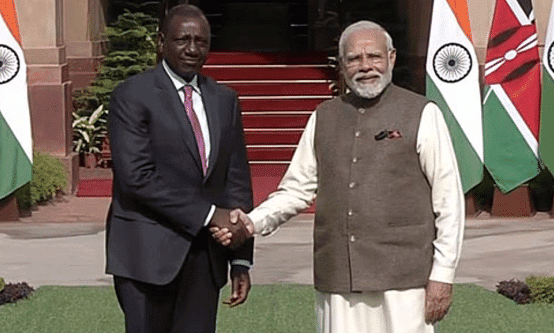
Context: India has pledged a $250 million line of credit to Kenya aimed at modernizing its agricultural sector.
Line of Credit to Kenya
- Kenya's Presidential visit to India comes after a gap of over six years and is anticipated to fortify and reinvigorate the bilateral relations between the two nations. Both countries have issued a vision document highlighting maritime cooperation in the Indian Ocean.
- During the visit, the two sides have inked five agreements, including a memorandum of understanding (MoU) on sharing successful solutions for digital transformation. Additionally, agreements have been made between the Indira Gandhi National Open University and the Open University of Kenya, on cultural exchanges for the period 2023-27, on collaboration between the Bureau of Indian Standards and Kenya Bureau of Standards, and on cooperation in sports.
- Furthermore, Kenya has opted to join the Global Biofuels Alliance and the International Solar Alliance.
What is the Line of credit (LOC)?
- A line of credit (LOC) is a preset borrowing limit that can be tapped into at any time.
- The borrower can take money out as needed until the limit is reached.
- As money is repaid, it can be borrowed again in the case of an open line of credit.
India-Kenya Relations: Bilateral Trade, and Economic Cooperation
- About: India and Kenya are maritime neighbors. The contemporary ties between India and Kenya have evolved into a robust and multi-faceted partnership, marked by regular high-level visits, increasing trade and investment and extensive people-to-people contacts.
- Bilateral Trade: An India-Kenya Trade Agreement was signed in 1981, under which both countries accorded Most Favoured Nation status to each other.
- India was Kenya’s largest trading partner in 2014-15 with bilateral trade of US$ 4.235 billion.
- Investment: According to the Kenya Investment Authority (KenInvest), India is the second largest investor in Kenya. Over 60 major Indian companies have invested in various sectors including manufacturing, real estate, pharmaceuticals, telecom, IT & ITES, banking and agro-based industries.
- Development Cooperation: India offers development assistance to Kenya through loans and credit. A LOC agreement of US$ 100 million for the Agricultural Mechanization Project was also signed in January 2017.
- Indian Community and Diaspora in Kenya: Indians were trading with the Swahili coast since early A vibrant community of persons of Indian origin presently numbered around 80,000 including an estimated 20,000 Indian citizens.
- Several Kenyans of Indian origin have distinguished themselves as lawyers, judges, doctors and academics.
- Vaccine Maitri: Kenya was given 1.12 million doses of AstraZeneca (1.02 million under COVAX alliance and 100,000 as gift from India).
Gujral Doctrine of Foreign Policy
Context: On November 30, the 11th death anniversary of IK Gujral, India’s 12th Prime Minister, is observed.
- Gujral's tenure as Prime Minister, lasting less than a year, often takes a backseat in discussions concerning India's heads of government.
- He is primarily acknowledged for the 'Gujral Doctrine', a distinct foreign policy approach named in his honor.
Understanding the Gujral Doctrine
- Background: Before becoming Prime Minister, Gujral served as the External Affairs Minister twice, during which he formulated his foreign policy approach.
- Five Principles: Outlined in a speech at Chatham House, London, the doctrine emphasized-
- Non-reciprocity in relations with neighbors like Nepal, Bangladesh, Bhutan, Maldives, and Sri Lanka,
- Non-use of territory against each other,
- Non-interference in internal affairs,
- Respect for sovereignty and territorial integrity, and
- Peaceful bilateral negotiations for dispute resolution.
- Exclusion of Pakistan: Notably, Pakistan was not included in the list of countries for non-reciprocal relations.
- Philosophy: The doctrine was based on leveraging India’s size and influence in South East Asia through a non-domineering attitude and continuous dialogue, even with Pakistan.
Achievements of the Gujral Doctrine:
- Fostering Regional Trust: The doctrine significantly bolstered trust and collaboration with India’s neighboring countries.
- Major Milestones: Noteworthy accomplishments encompassed the ratification of a 30-year water treaty with Bangladesh and favorable advancements in relations with Bhutan and Nepal.
- Enduring Impact: Subsequent Prime Ministers, spanning varying political ideologies, continued to adopt certain principles of this doctrine.
Critique and Constraints:
- Perceived Indulgence: Gujral encountered censure for appearing excessively indulgent, particularly in dealings with Pakistan, potentially exposing India to future vulnerabilities.
- Perception in Pakistan: Certain factions within Pakistan perceived the doctrine as an Indian maneuver aimed at isolating Islamabad.
Gujral’s Personal Influence on the Doctrine
- Background: Born in undivided Punjab and a participant in the freedom struggle, Gujral was known for his politeness and firmness in politics.
- Stance during the Emergency: As Information Minister, he reportedly resisted Sanjay Gandhi’s orders to stifle the press.
- International Relations Stance: Gujral was outspoken in his views, notably critiquing Britain’s suggestion to mediate over Kashmir.
Legacy in India’s Foreign Policy
- Impact on India’s Foreign Policy: Gujral’s approach left a lasting influence on India’s foreign policy, particularly in its relations with neighboring countries.
- Recognition and Remembrance: His doctrine is remembered as a significant contribution to India’s diplomatic strategy, reflecting his understanding of regional dynamics and India’s role in South East Asia.
Conclusion
- The Gujral Doctrine serves as a testament to IK Gujral's diplomatic expertise and his vision for India's role within its nearby regions.
- His strategy, emphasizing cooperation, non-reciprocity, and dialogue, continues to shape India's foreign policy choices and its associations with neighboring nations.
Sri Lanka’s Debt Crisis and Paris Club
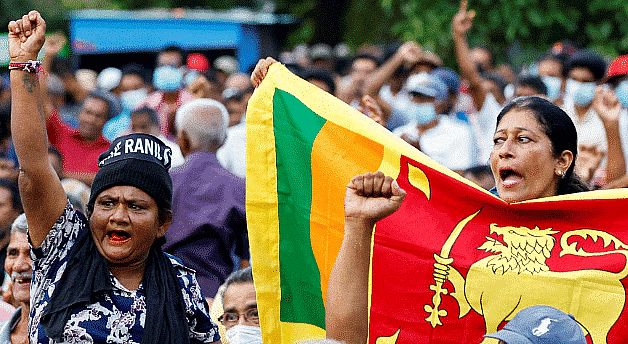
Context: Sri Lanka has tentatively agreed with India and the Paris Club group of creditors on a plan for debt treatment.
What is the Agreement in Principle for Debt Treatment Plan?
Objective and Parameters:
- Aimed at facilitating the disbursement of the next tranche of the International Monetary Fund’s nearly-$3 billion recovery package.
- The Official Creditor Committee (OCC) and Sri Lanka agreed on main parameters aligned with the Extended Fund Facility (EFF) arrangement with the IMF.
- The Extended Fund Facility (EFF) provides financial assistance to countries facing serious medium-term balance of payments problems because of structural weaknesses that require time to address.
Formalization Process:
- The OCC looks forward to formalizing the agreement in the coming weeks through a Memorandum of Understanding with Sri Lanka.
- The OCC expects “other bilateral creditors” to share information transparently for evaluating comparability of treatment.
Emphasis on Creditor Parity and Transparency:
- Japan and India stress the importance of creditor parity and transparency in the restructuring process.
What is the Paris Club?
- The Paris Club comprises an informal assembly of creditor nations united by the goal of finding viable solutions to payment challenges faced by debtor nations.
- Membership: The club consists of 22 permanent members, encompassing a majority of Western European and Scandinavian nations, the United States, the United Kingdom, and Japan.
- India’s Role: India's involvement is intermittent and ad-hoc.
Official Creditor Committee (OCC):
- In response to Sri Lanka's plea for debt relief during last year's economic turmoil, the OCC was established.
- Co-Chairmanship: The OCC is co-chaired by India, Japan, and France, with France serving as the chair of the Paris Club.
- China's Participation: China, being Sri Lanka's primary bilateral creditor, chose not to be an OCC member but participated in meetings as an observer.
India’s Support to Sri Lanka:
- Financial Assistance: India extended a USD 4 billion aid package in alignment with its 'Neighbourhood First' policy, utilizing credit lines and currency support.
- IMF Financing Assurance: As the primary bilateral creditor, India provided financial assurance to the IMF, enabling a structured program for Sri Lanka.
- Economic Partnership Vision Document: India released a comprehensive document outlining specific areas of cooperation for sustainable economic growth and prosperity.
- Special Grant Package: During President Ranil Wickremesinghe's visit to India, a special grant package of SLR 3 billion was announced for diverse projects in the IOT community.
Universal Declaration of Human Rights At 75
Context: The 75th anniversary of the Universal Declaration of Human Rights was observed on December 10, commemorating its adoption by the UN General Assembly in Paris.
- This declaration, established after World War II, formed the cornerstone of the international order, seeking to prevent future atrocities.
Understanding the Universal Declaration of Human Rights
- Document Structure: Comprising a preamble and 30 articles, it outlines fundamental rights and freedoms.
- Key Provisions: Articles emphasize equality in dignity and rights, non-discrimination, the right to life and liberty, prohibition of slavery and torture, fair trial rights, asylum rights, and freedoms of religion, opinion, expression, and assembly.
- Right to Education: The declaration also enshrines the right to education for all.
Origins and Development
- Post-War Sentiment: Born from the “never again” resolve after the world wars and the Holocaust, it served as a “road map” for individual rights.
- Drafting Process: Chaired by Eleanor Roosevelt, the drafting committee represented diverse geographical regions, with over 50 countries contributing to the final draft.
- Global Participation: Despite being drafted during widespread colonial rule, the declaration represented a collective effort, ensuring rights for all, including gender equality.
Impact and Legacy:
- Despite not being legally binding, its principles have influenced both national laws and international human rights treaties. It has served as inspiration for movements such as decolonization, anti-apartheid efforts, and various global human rights movements. Despite facing criticisms, it continues to be a universal standard for human rights, influencing subsequent human rights agreements.
Current Challenges and Relevance:
- The declaration's anniversary coincides with ongoing human rights challenges in conflicts such as Israel-Hamas, Russia-Ukraine tensions, and internal turmoil in Myanmar and Sudan. UN Secretary-General Antonio Guterres has expressed concerns about the misuse and abuse of the declaration by certain governments.
- Amnesty International regards the declaration as evidence of the possibility of a global human rights vision. UN High Commissioner for Human Rights Volker Türk emphasizes the enduring relevance of the declaration, urging the world to acknowledge its achievements and learn from its shortcomings.
Conclusion: Upholding the Universal Declaration
- Inherent Human Rights: The declaration underscores that human rights are intrinsic to every individual.
- Leaders’ Responsibility: Leaders are reminded of their duty to uphold these rights, essential for the well-being of the people they serve.
|
88 videos|123 docs
|
FAQs on International Relations: December 2023 UPSC Current Affairs - UPSC Mains: International Relations
| 1. What is illegal Indian migration to the U.S.? |  |
| 2. What are the reasons behind illegal Indian migration to the U.S.? |  |
| 3. How do illegal Indian immigrants enter the U.S.? |  |
| 4. What are the consequences for illegal Indian immigrants in the U.S.? |  |
| 5. What measures are being taken to address illegal Indian migration to the U.S.? |  |


